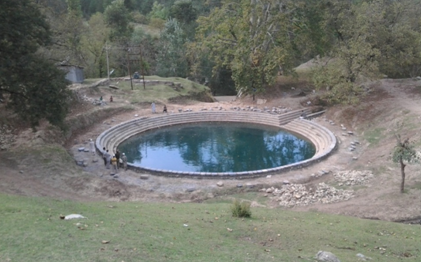HERITAGE
During these hot summers, the Mughal gardens of Kashmir have been observing huge rush of local as well domestic tourists. May it be the Mughal gardens of Srinagar or more distantly situated Mughal gardens and springs in south Kashmir, the local and domestic tourists have been visiting and enjoying the glory of these Mughal gardens and of its cool water springs. The glorious springs and gardens of Verinag and Achabal in Kashmir have these days become the busiest tourist sites for the tourist traffic.
In fact these are the traditional tourist sites and very much appear on the tourist map of Kashmir, but there are several other glorious heritage tourist sites which if developed could have also become the major picnic spots. One such forgotten heritage site is of ancient archaeological remains and spring at Kothair, hardly situated at a distance of 7 to 8 km from the busiest tourist site of Achabal Mughal garden.
Although thousands of tourists throng to Mughal garden at Achabal but none of them ever visits to this Historic Spring and its ancient archaeological remains. It just looks like an abandoned site and perhaps does not appear on the tourist map, although this site very much exists on the archaeology map of this land. The site consists of an ancient spring and archaeological remains and is located in the small hamlet of Kothair in the green forests range of paragon Kothar which divides the two historic paragons of Bring and Kothar. The mysterious spring with its banks showcases the ancient archaeological remains locally known as ‘Pandulare’ (remains of Pandu buildings) is really worth seeing.
In ancient times it has been known by the name of ‘Papa sudan Nag’ means Sin washing spring. A curious tradition held by ancient people and recorded in history literature states that the waters of this spring have healing powers and anybody taking bath with its waters would wash off one’s sins. A curious tradition preserved in the local Hindu folklore states that people in ancient times used to bath in this spring and with its healing powers, the water of this spring washed their sins. This spring has also been called Kapteshwara spring and the village where this spring is located has also derived its name from ancient spring.
Kashmir valley is the land of ancient springs which have carried curious legends associated with those. There are plenty of springs found in Kashmir which are broadly classified into two major categories – hilly and plain springs. Hilly springs are those springs which are found on its hills, mountains and plateaus. Such springs rise from the rocks and then flow down towards the valley plains. While the plain springs rise in the plain valleys. People still regard these springs in high esteem for the fact that many curious legends are associated with them.
Although due to geological and environmental changes several of these ancient springs have already disappeared but still several village sites had got a natural spring either small or large.
The large springs in valley’s dialect are called ‘Nagas’, while the little springs as ‘Nagin’ which denotes a female consort. Basically Naga in olden traditions meant a deity believed to have been worshiped here in the ancient periods. Historians believe that in the fourth and fifth century BC, Naga worship may have been the principal religion in Kashmir.
They write “When Budhism was the predominant faith, one of the early Kings, Gonanda, is said to have revived the ancient form of Naga worship as prescribed by Nilmathpurna. We also have the legend of Susravas Naga and mention of Padam Naga, at the Wular Lake.” Kalahana mentions the annual festival of Takasaka- Naga at village of Zewan which was frequented by donnrs and strolling players and thronged by crowds of spectator.
Since Naga worship has almost disappeared here but the sites associated with this tradition are still being held in good respect. Kashmir mystics also held these springs in good esteem.
This ancient spring at Kothair revealing myths and curious traditions have added a lot to one’s curiosity. The historic spring is also called locally as Papa Sudan nag. The name given in Sanskrit—Papa Sudan also denotes the same meaning and means “sin washer.”
This historic spring has also got its mention in Kalhana’s Rajtarangni, by the name of kaptishvara. A tradition recorded in this 12th century chronicle states, that a man from plains known as padmaraja—the importer of Tambala leaf—-became friends with king Bhoja—the supreme lord of Malwa, by remitting heaps of gold through him to construct a pool at kapastevara, besides, taking a vow to wash his face, with the waters of this spring.
Another tradition states that the spring tank was built by one Dacen raja called Matshankund—-who is said to had ears like that of a buffalo which he had dropped after bathing with the healing spring waters.
The following line of the kashmiri folklore was very much sung in olden times here.
Makun razas Mounshi kan
Su Kate baliyas kothair wan
(Raja Makan had Buffalo ears which got treated at kothair forest)
However, these saying are almost all myths which have no scientific and historical bases. Clearly speaking, this is really an ancient site, but it has never been explored on scientific lines. The ancient spring on its banks showcases the remains of few ancient buildings. These remains are mostly the basement of some ancient structures symbolizing the medieval period stone architecture of Kashmir.
Although the spring and remains have been notified as state protected monument and very much appears on the archaeology map of Kashmir, but it is still to be investigated. The site has been fenced and the arcade around the spring has also been renovated but the remains of the site are still unexplored. The site has no basic tourist infrustructure; as such steps are required to be taken to explore and conserve this archaeological site and promote it as the heritage site of the area.
(Author is archeologist and a freelancer. He can be reached on: [email protected])








